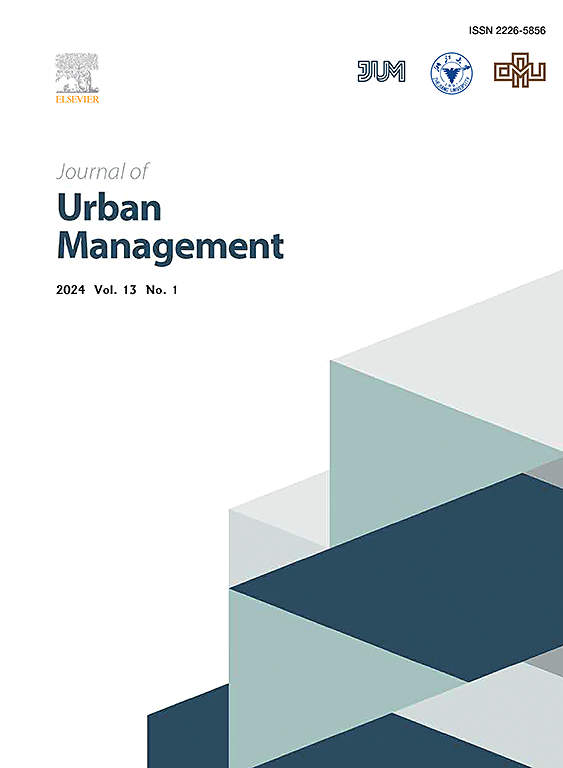了解伊拉克巴古拜的城市扩张:影响因素研究
IF 5
2区 社会学
Q1 URBAN STUDIES
引用次数: 0
摘要
城市扩张对城市可持续性、空间效率和社会公平构成了重大挑战,尤其是在资源受限的中型城市。本研究解决了理解伊拉克巴古拜城市扩张和密度化过程之间相互作用的关键空白。巴古拜是一个在固定空间边界内经历人口快速增长的城市。本研究采用综合方法框架,利用来自Landsat 7、8和9数据集的卫星图像,使用ENVI、GIS和谷歌Earth软件进行辐射校正预处理。通过最大似然分类方法对土地覆盖数据进行分类,揭示了三十年(1992年、2007年和2022年)的空间变化。为了分析城市增长动态,霍尔德伦指数量化了人口增长和人均土地利用变化的贡献。采用Moran指数、高低聚类和热点分析等空间自相关方法检测聚类模式和显著空间热点。此外,MICMAC结构分析方法确定了城市扩张关键驱动因素之间的相互依赖性。研究结果表明:1992 - 2022年,巴古拜的城市增长主要表现为密度化,建成区面积从33.29%增加到46.55%;住房投资、形状指数、经济增长和规划政策等因素成为形成这些模式的关键驱动因素。研究强调了可持续发展战略,包括垂直扩张、绿色基础设施保护、参与式治理和先进的空间监测,以减轻城市扩张的不利影响,同时促进城市可持续发展。这些见解为解决类似中等城市的城市化挑战提供了一个可复制的框架。本文章由计算机程序翻译,如有差异,请以英文原文为准。
Understanding urban sprawl in Baqubah, Iraq: A study of influential factors
Urban sprawl poses significant challenges to urban sustainability, spatial efficiency, and social equity, particularly in mid-sized cities within resource-constrained settings. This study addresses critical gaps in understanding the interplay between urban sprawl and densification processes in Baqubah, Iraq, a city experiencing rapid population growth within fixed spatial boundaries. Employing an integrated methodological framework, this research utilized satellite imagery from Landsat 7, 8, and 9 datasets, preprocessed with radiometric corrections using ENVI, GIS, and Google Earth software. Land cover data were classified through the maximum likelihood classification method to reveal spatial transformations over three decades (1992, 2007, and 2022). To analyze urban growth dynamics, the Holdren Index quantified the contributions of population growth and per capita land use changes. Spatial autocorrelation methods, including Moran's Index, High/Low Clustering, and Hot Spot Analysis, were applied to detect clustering patterns and significant spatial hotspots. Additionally, the MICMAC structural analysis method identified interdependencies among key drivers of urban sprawl. The findings indicate that urban growth in Baqubah from 1992 to 2022 has predominantly manifested as densification, with built-up areas increasing from 33.29% to 46.55%. Factors such as housing investment, shape index, economic growth, and planning policies emerged as critical drivers shaping these patterns. The research emphasizes sustainable strategies, including vertical expansion, green infrastructure preservation, participatory governance, and advanced spatial monitoring, to mitigate the adverse effects of sprawl while promoting sustainable urban development. These insights offer a replicable framework for addressing urbanization challenges in comparable mid-sized cities.
求助全文
通过发布文献求助,成功后即可免费获取论文全文。
去求助
来源期刊

Journal of Urban Management
URBAN STUDIES-
CiteScore
9.50
自引率
4.90%
发文量
45
审稿时长
65 days
期刊介绍:
Journal of Urban Management (JUM) is the Official Journal of Zhejiang University and the Chinese Association of Urban Management, an international, peer-reviewed open access journal covering planning, administering, regulating, and governing urban complexity.
JUM has its two-fold aims set to integrate the studies across fields in urban planning and management, as well as to provide a more holistic perspective on problem solving.
1) Explore innovative management skills for taming thorny problems that arise with global urbanization
2) Provide a platform to deal with urban affairs whose solutions must be looked at from an interdisciplinary perspective.
 求助内容:
求助内容: 应助结果提醒方式:
应助结果提醒方式:


